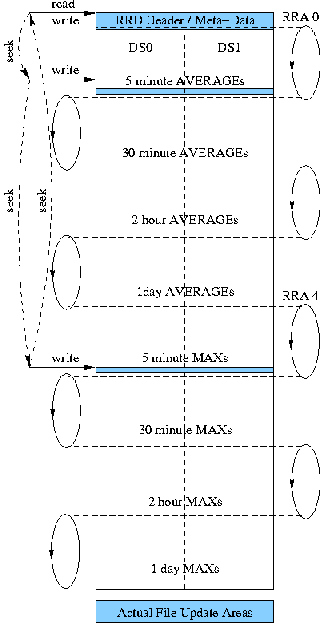

An operating system's readahead and buffer-cache behaviors can significantly impact application performance; most often these better performance, but occasionally they worsen it. To avoid unintended I/O latencies, many database systems sidestep these OS features by minimizing or eliminating application file I/O. However, network traffic measurement applications are commonly built instead atop a high-performance file-based database: the Round Robin Database (RRD) Tool. While RRD is successful, experience has led the network operations community to believe that its scalability is limited to tens of thousands of, or perhaps one hundred thousand, RRD files on a single system, keeping it from being used to measure the largest managed networks today. We identify the bottleneck responsible for that experience and present two approaches to overcome it.
In this paper, we provide a method and tools to expose the readahead and buffer-cache behaviors that are otherwise hidden from the user. We apply our method to a very large network traffic measurement system that experiences scalability problems and determine the performance bottleneck to be unnecessary disk reads, and page faults, due to the default readahead behavior. We develop both a simulation and an analytical model of the performance-limiting page fault rate for RRD file updates. We develop and evaluate two approaches that alleviate this problem: application advice to disable readahead and application-level caching. We demonstrate their effectiveness by configuring and operating the world's largest [Note 1] Multi-Router Traffic Grapher (MRTG), with approximately 320,000 RRD files, and over half a million data points measured every five minutes. Conservatively, our techniques approximately triple the capacity of very large MRTG and other RRD-based measurement systems.
Sometimes common case optimizations by the operating system can adversely affect an application's performance instead of improving it. For instance, in most OS, readahead intends to optimize sequential file access by reading file content into buffer-cache with the expectation that it will soon be referenced. In this paper, we identify and remedy a situation in which the performance of a popular time series database, the Round Robin Database (RRD) Tool, is adversely affected by the default OS readahead and caching behaviors.
We present an investigative method to discover the RRD system's performance bottleneck and an analysis of the bottleneck identified: the OS default file readahead and caching behavior. We describe two approaches to optimize system resource usage for maximum performance: (i) application advice to the OS to disable readahead and (ii) application-level caching. We validate our results by configuring and operating a Multi-Router Traffic Grapher (MRTG) system that performs over a half a million measurements every five minutes and records them into a set of 320,000 RRD files in near real-time. We identify the additional factors that limit further scalability of the RRD system after these improvements. We also discuss OS improvements to the readahead behavior that could generally avoid the application performance problem we observed.
We investigate the scalability issues in a real world scenario. During the deployment of new network equipment (routers and switches) over the past few years at our university, the number of manged devices grew significantly, nearly doubling each year. This required our network measurement system's capacity to scale similarly. Today, for approximately 60,000 measured network interfaces, about 160,000 RRD files need to be updated every five minutes. These record interface byte, packet, and error rates. As the number of measurement points grew with the network size, we found that an increasing number of measurements did not get recorded into the database within the required five minute interval (20 to 80 percent failures).
We are motivated to study the scalability issues of RRD for two main reasons: (i) we were confounded by our system's poor performance given that it is generously-sized with respect to processor, memory, and disk, and (ii) any performance gains achieved would benefit many, given the popularity of RRDTool. To the first point, our prior understanding of RRD file structure and access patterns led us to believe the amount of work should not overwhelm our system. RRD files are organized in such a way that a small number of blocks are accessed per update cycle. The set of blocks in a series of updates has a low entropy: that is, most updates touch the same set of blocks. Thus, we were of the opinion that the "working set" of blocks for the RRD files in our system could reside completely in the OS file buffer-cache. Unexpectedly, our system's CPU spent the majority of its time in an "I/O wait" state due to disk reads.
To study the state of the buffer-cache, we wrote a tool called fincore that exposes the cache "footprint" of a given set of files; it takes a snapshot of the set of file blocks or pages in the buffer cache. This helps us determine at any given time what pages were brought in memory by the OS and helps us discover the readahead effects. We are also able to study the average number of pages per file brought into the memory by an unmodified MRTG. This helps us determine the maximum number of RRD files the system could handle with fixed hardware resources. We wrote another tool called fadvise that can advise the operating system about the file access pattern using the posix_fadvise system call. This tool enables the user to forcibly evict any file's pages from the buffer-cache, providing a key function in controlled experiments.
Our work makes the following contributions:
The remainder of this paper is organized thusly: We first provide background on MRTG and RRD, and introduce our network measurement system. Next, our investigation technique is described in the "Method and Tools" section. Then two complementary performance optimizations to RRDTool are presented in the and "Application-Offered Advice" sections. The subsequent "Analysis" section contains our analytical model and simulation details. Ultimately, in the "Scalability" section, we report the scalability of the optimization techniques by running what we suggest is the world's largest MRTG on a single server. Therein we also discuss the factors limiting the further scalability of RRDTool after these improvements. The "Related Work" and "Discussion and Future Work" sections follow and we close with our conclusions.
The Multi-Router Traffic Grapher (MRTG) is a perl script that collects network measurements and stores them in RRD files. Figure 1 shows a simplified MRTG in pseudo-code form. MRTG performance is satisfactory as long as it can consistently complete one loop iteration, consisting of one "poll targets" and one "write targets" phase, in less than the update interval, typically five minutes (300 seconds.)
# read configuration file
# to learn targets
readConfiguration();
do {
# POLL TARGETS:
# collect values via SNMP:
readTargets();
# WRITE TARGETS:
# update values in RRD files:
foreach my $target (@targets) {
RRDs::update(...);
}
sleep (...); # sleep balance
# of 300 seconds
} while (1); # forever
MRTG refers to the configurable metrics it collects as Targets. Each target consists of two objects collected via SNMP, typically one inbound and one outbound measurement for a given network interface, i.e., a router or switch port. Thus, the number of targets per network device is typically a function of its number of interfaces.
The paired objects are each referred to as a Data Source (DS) in a Round Robin Database (RRD). The RRD file name itself and the file's Data Sources define the database "columns." Round Robin Archives (RRAs), or tables of values observed at points in time, are the database "rows." Figure 2 shows a typical RRD file managed by MRTG.

RRD performance is influenced by the RRAs defined within a file. Each RRA has an associated consolidation function, such as AVERAGE or MAX, that operates on a set of one or more Primary Data Points (PDPs), i.e., data points collected at the measurement interval. Additional RRAs typically require additional work to be done periodically, such as on every half hour, two hours and one day. These aggregation times are defined as offsets from zero hours UTC. Thus all like-configured MRTG RRD files require aggregations to be done every half hour, more every two hours, and then the most aggregations at midnight.
Our MRTG system use RRDTool and currently measures approximately 3,000 network devices. Primarily, the devices are switches and routers in our campus network including those in the core and distribution layers and most of the network equipment at the access layer, serving users in approximately 200 campus buildings.
In this work, we refer to this production MRTG network measurement system as the System Under Test (SUT.) The SUT's characteristics including its software are summarized in Table 1. [Note 2] The system's page size is 4KB and our file-systems are configured with a 4KB block size. Thus, we will conveniently use the terms "block" and "page" interchangeably when referring to segments of a file whether they are on disk or in memory.
| Component | Characteristics |
| Processors | 8 × Intel Xeon @ 2.7 GHz |
| Processor Cache | 2 MB |
| Memory | 16 GB |
| Disk | SAN: RAID-10, 16 × 2 disks |
| Operating System | Linux 2.6.9 |
| File System | ext3 and ext2, 4KB blocksize |
| I/O Scheduler | Deadline |
| Software | Version |
| MRTG | mrtg-2.10.5 |
| RRDTool | rrdtool-1.0.49 |
As our centrally-manged network has grown, our MRTG system has grown in terms of computing power and storage. One significant technique we employ to improve MRTG's scalability is to divide the targets amongst a configurable number of MRTG daemons that we increase as our number of targets increases; we process about 10,000 targets per daemon. So, our one MRTG "instance" is actually a collection of MRTG daemons running on one server. Another dimension in which our MRTG system is larger than most is that we resize RRA 0 (the five minute averages) to store up to one year or five years of data. This increases an MRTG RRD file's size from the typical 103 KB to 1.7 MB or 8.2 MB, respectively, of course requiring much more disk space. (We see that this does not adversely affect performance in the "Analysis" section.)
Prior to this work, our network growth exceeded the scalability of the SUT. The Appendix lists system and MRTG configuration recommendations that we've tested and used in our system to meet our performance goals.
We started by examining the SUT's activity to determine the nature and extent of the performance problem. We present three measurements that led us to the root cause of the problem and that allow us to evaluate potential solutions.
First, we measured the time to completion of each measurement interval by each MRTG daemon on our system, with approximately 160,000 targets in total. As shown in Figure 1, this consists of two phases, first polling the network statistics via SNMP and then updating the pertinent RRD files. Figure 3 is a scatter plot with the measurement's time of day on

Further examination reveals that the CPU was in I/O wait state for a majority of the time. Figure 4 shows the CPU utilization. The user and system CPU utilization levels are ~20% and ~10%, respectively, and are not the bottleneck. However, the CPU is spending more than half its time in the I/O wait state. Thus, the CPU wastes most of the time waiting for I/O to complete.
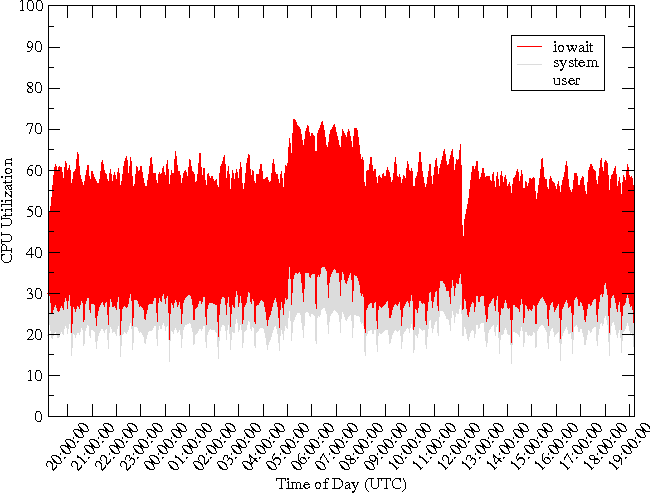
To understand the I/O wait, we studied the actual number of reads and writes involving the disk. Unexpectedly, the system was doing close to 90,000 reads per second (see Figure 5.) In contrast, the number of writes was stable at ~12,000 writes per second. The high number of reads suggests that files are not being cached effectively. This led us to examine the contents of the buffer-cache to determine why.

The system's buffer-cache content gives a good indication of which files' accesses are benefiting from caching in core memory. Unfortunately, a system's buffer-cache content is generally hidden from users and user processes. Prior work has resorted to timing file block accesses to surmise whether or not a given page already resides in the buffer-cache memory [4]. While suitable in some situations, this technique is indirect and has the unwanted side-effect of modifying the cache because it references the pages about which it inquires, causing them to be brought into cache and likely evicting other pages. Thus, a user tool to passively investigate buffer-cache content is desired.
We introduce a new user command called fincore that is used to determine which segments of a file are in core memory, presumably because they reside in the buffer-cache. The fincore command takes file names as arguments and displays information about file blocks or pages in memory. The fincore command uses two common system calls to accomplish this: mmap and mincore. That is, it first maps a file into its process' address space, then asks which pages of that segment of the process' address space are in core at that time. [Note 3] Using fincore we were able to uncover the readahead effects on the buffer-cache. As an optimization, Linux reads pages ahead from the disk into the buffer, anticipating locality of subsequent reads. This improves performance for most applications by decreasing subsequent read latencies. With the current implementation of RRDTool, the readahead can have a highly adverse impact on performance and scalability. A brief discussion of the readahead algorithm within the context of the RRD file shown in Figure 2 can make this clearer.
The readahead algorithm tries to guess whether the file being accessed is going to be read sequentially (when readahead is actually useful) or randomly. On an RRD file update, the first read is for the meta-data at file offset zero, i.e., the beginning of the file. The maximum readahead window size is 32 blocks for ext2 and ext3, and, on an initial read, the readahead window starts at half that maximum in anticipation of sequential access. So, 16 pages are read into buffer-cache when the application read just one. The file offset of the second block needed to update the AVERAGE RRA depends on the current update position within the RRA.
For the typical MRTG RRD file, this will lie within the first 16 pages. The file offset of the third block needed for the MAX RRA update sometimes lies beyond the first 16 pages which can lead to further 8 pages being read in to the memory. (Eight pages are read as the readahead algorithm reduces the readahead window at the random seek into the MAX RRA.) These file block accesses are depicted in Figure 6.

A typical RRD file update consists of two RRA updates (AVERAGE and MAX). With the default readahead, most blocks that are read in are unnecessary. In the event of data kept over a longer period of time, as in our case with five minute averages for one year or five years, the write for the AVERAGE RRA often lays well beyond the first 16 pages. The readahead window is reduced to 8 pages for the next random read for the AVERAGE RRA update and then to 4 for the subsequent random read for the MAX RRA update. The readahead algorithm starts to adapt to the random reads by reducing the readahead window. A typical RRD file update requires just three block updates, yet we end up bringing 28 (16+8+4) blocks into the file cache. The file is then is closed which causes the adapted readahead value to be lost, reverting to 16 the next time the file is opened. For the typical RRD file with 800 recorded values, we end up bringing almost the full file into cache. If we could bring just the required "hot" blocks into the file cache by suppressing readahead from the beginning, we would get better performance and scalability.
We see that the number of blocks most often required per MRTG RRD file per update is three. Based on our fincore observations (in the "Analysis" section), we note that there is also a low "churn" rate of these blocks. That is, once fetched into memory, these blocks were useful for a long period of time. If we were caching only the required blocks, there would be no waiting on reads, eliminating our performance problem.
Due to the default readahead behavior, we must wait for reads from the disk since we find almost nothing useful in cache. This is because, for instance for the file cache to accommodate 300,000 RRD files, 300,000 × 24 × 4 KB (close to 30 GB of memory for the cache) are required. Since the file cache isn't that large, the page replacement policy evicts the pages that will be needed later. However, with suppressed readahead, we would cache just three blocks per file: 300,000 × 3 × 4 KB (3.6 GB) and an order of magnitude less memory is required to fit everything desired in file cache. Actual buffer-cache behavior for RRD files is not quite as simple as this example; see the "Analysis" section for details.
For repeatable experiments involving the buffer-cache, we require fine-grained control over the buffer-cache content. For instance, one run of an experiment such as an RRDTool update, brings pages of the RRD file from the disk into the buffer-cache. If we wish to see the effects of a subsequent update (reading the pages again from the disk), we need to evict the pages that were brought in earlier. Generally, the only methods available to forcibly evict pages from the buffer-cache were to either (i) unmount the file-system containing the cached files or (ii) populate the cache with hotter pages by accessing other content more frequently or more recently, thus invoking the systems page replacement algorithm to evict the unwanted pages. To perform controlled experiments we wanted a more convenient method for a user to forcibly evict specific files' blocks from the buffer-cache. To do so, we introduce a new user command called fadvise that is used to provide file advisory information to the operating system. The fadvise command takes file names as arguments.
Our typical use of fadvise is to advise the system that we "don't need" a file's blocks and that we'd like them to be evicted from the buffer-cache. [Note 4] In this case, the file is first synchronized so that its dirty pages are transferred to the storage device, e.g., the disk, and then the advice is issued. The fadvise command uses the fsync then fadvise system calls to accomplish this.
We've described our system and showed that it does not meet our performance goal. A number of RRDTool users have proposed significant modifications to RRD measurement systems to improve performance by modifying I/O behavior [22, 12, 9]. These proposals generally involve intercepting RRD file updates and recording them to be written later. The updates are thus deferred, then later coalesced and written. The result is improved performance by the introduction of an independent thread to perform application writes and by the better locality characteristics of these periodic, coalesced writes.
Since this essentially implements a buffer-cache within the application, we call this technique application-level buffering.
We now describe our application-level buffering implementation called RRDCache, shown in Figure 7. RRDCache has three main components:
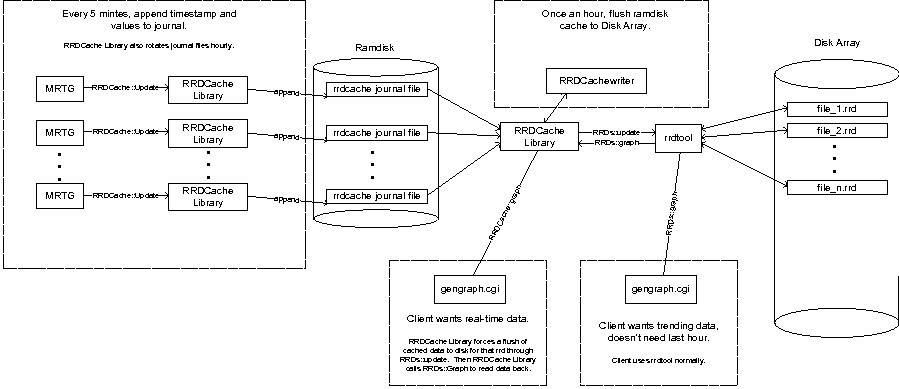
Normally an MRTG daemon (or any application that uses RRD files) accesses RRD files on disk directly by using the RRDTool API. With RRDCache, MRTG and other applications instead call functions in the RRDCache library. RRDCache presents the same API as the RRDTool. So, when an MRTG daemon calls the RRDCache:update function, the arguments are appended to a RRDCache journal file associated with calling process, i.e., the MRTG daemon.
The RRDCache journal file is located on the tmpfs file-system, eliminating disk I/O for the update. Periodically (once every hour), the RRDCachewriter runs to process any new data that has been written to the RRDCache journal files. The RRDCachewriter handles the updates from the journal files by committing the update to the appropriate RRD files on disk. In the process, it coalesces all the updates meant for a particular RRD file. If the requisite file pages are not already present in the buffer-cache, this has the benefit of bringing them into memory much less frequently. The RRDCachewriter can be run more often if the tmpfs runs out of space between runs. (We have been using 1 GB of our main memory for the tmpfs file-system and that has proven to be sufficient for the 160,000 targets polled at five minute intervals.)
The performance of the measurement system using RRDCache is much improved. For our MRTG system, Figure 8 shows the results. We see that the MRTG daemons finish in well under 60 seconds which includes both the polling and writing. Contrast this with Figure 3, in which most of the updates were not achieving even the five minute performance goal.
Since the RRD file updates were performed by RRDcachewriter once an hour, and ordered by RRD file, there is a limited amount of I/O wait by the CPU at the start of every hour (Figure 8). This I/O wait is much less than the original system's I/O wait shown in Figure 4. The CPU utilization by the user and system processes remains the same as before.
Also evident in Figure 8 are spikes in disk read and write activity once per hour as the updates are being transfered from the journal buffer to the RRD files on disk. These disk I/O rates are much lower than the original system's rates shown in Figure 5.
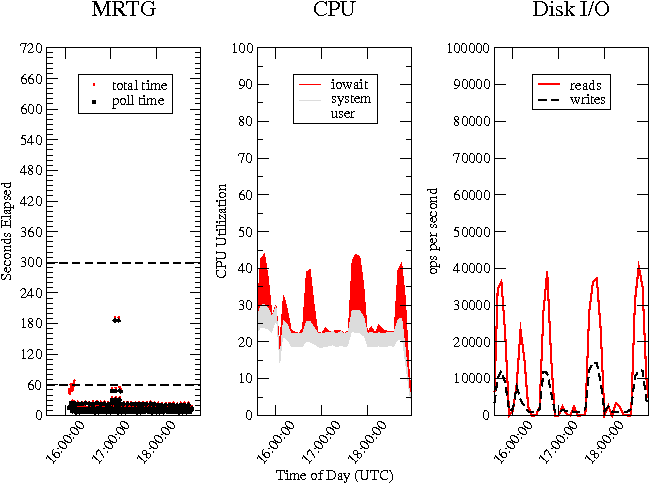
One complication of RRDCache's technique is that the application-level journal buffer is not readable by RRD applications other than the RRDCachewriter; currently it is just a buffer for writing, not a cache for reading. While updates reside in the RRDCache journal buffer, they can't be directly accessed by applications that may wish to graph recent measurements, for instance. Thus RRDCache slightly changes near real-time access semantics for RRD files. To work around this, RRDCache provides a graph function that immediately flushes pending updates from the journal buffer into RRD files upon attempts to read them and then returns the result of the RRDs::graph function. Applications then have the option of accessing RRD files directly through the RRDs interface, thus reading perhaps only older data suitable for trend analysis. However, performance would degrade if applications were to read every RRD file once per update interval (e.g., five minutes) to retrieve the most recent measurements, reverting to approximately the poor performance originally observed. If ever this becomes a problem, RRDCache could be improved so that its journal buffer is a true buffer-cache, consistent amongst both reading and writing processes. [Note 6]
We find sufficient motivation to avoid the operating system default readahead and buffer-cache behaviors because of the latencies observed while updating RRD files. In the previous section, we've shown that modifications that drastically reduce RRDTool's file I/O can achieve better performance by working around the operating system's default behavior.
In this section, we instead improve performance by directly influencing the operating system behavior. Specifically, we identify a mechanism to cause just the desired RRD file blocks to be read and cached.
One technique to suppress readahead is to use the posix_fadvise system call. This allows applications to advise the operating system of their future access patterns of files. The application identifies regions of an open file (by offset and length) and offers hints as to whether it will access them sequentially (the default) or randomly. Additionally, the application can inform the OS whether or not it expects to access those file regions again in the near future. Thus, for RRD files, we are able to advise the OS that the file accesses will be "random." This turns off readahead. The result is that only the "hot" blocks shown in Figure 6 are read and cached. For Linux 2.6.9 with fadvise RANDOM, on a typical five minute update only three blocks are cached.
The benefit of disabling readahead is realized immediately. Figure 9 shows the time elapsed per loop iteration of each MRTG daemon. With a system of 162,000 RRD files serviced by 19 MRTG daemons, we see that they finish within 60 seconds including both the polling and writing phases. This is contrasted with Figure 3 where we see that most of the updates do not meet our five minute performance goal. This also suggests that we can monitor even more targets within a five minute interval. Note that the increase in the time to update at zero hours UTC is due to aggregation (of the AVERAGE and MAX values) that is synchronized across all RRD files, and a potential performance limitation that we also discuss. The performance potential and limitations are further explored in the "Scalability" section.

As expected, the CPU is largely freed from waiting on I/O to complete (Figure 10). Again comparing with Figure 4, we note that the CPU utilization by the user level processes and the system remains the same as before. The significant difference is the low amount of waiting on I/O by the system when the readahead is suppressed. This implies a lowered number of reads with the buffer-cache becoming much more effective in caching the needed blocks. This is validated by our measurement of the reads issued to the disk per second by the system (Figure 11). The performance gain is significant, reducing approximately 90,000 reads per second to about 100 reads per second.
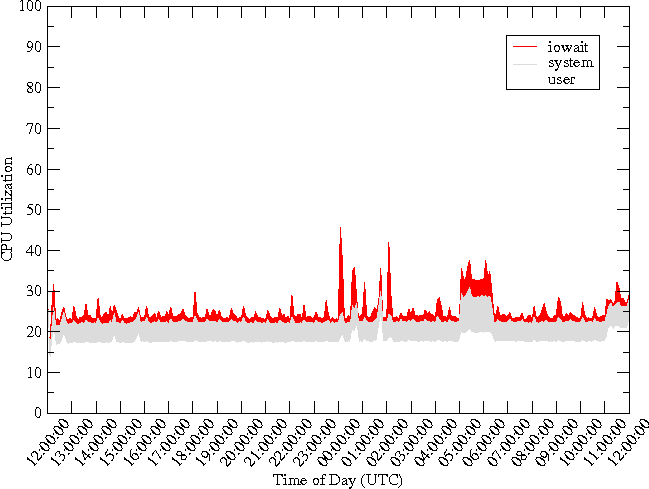
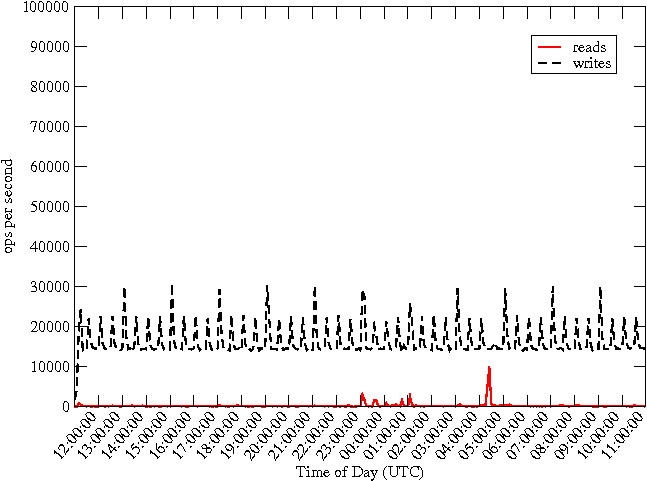
Figure 12 shows the plot of the proportion of RRD files vs. the number of blocks cached for both the original system without fadvise and the modified one with fadvise. One can see the sharp decrease in the number of blocks cached by the modified system with fadvise compared to the original system. For the original system, a sharp inflection point occurs at 27 pages. This indicates for a majority of the RRD files 27 pages were required. Also, the original system required more pages per file but couldn't fit them in the buffer-cache. For the modified system with fadvise, the inflection point occurs at 8, where the system requires 8 pages for most of the RRD files. Since the buffer-cache has space available for more pages, some of the RRD files get to keep more than 8 pages in the buffer-cache.
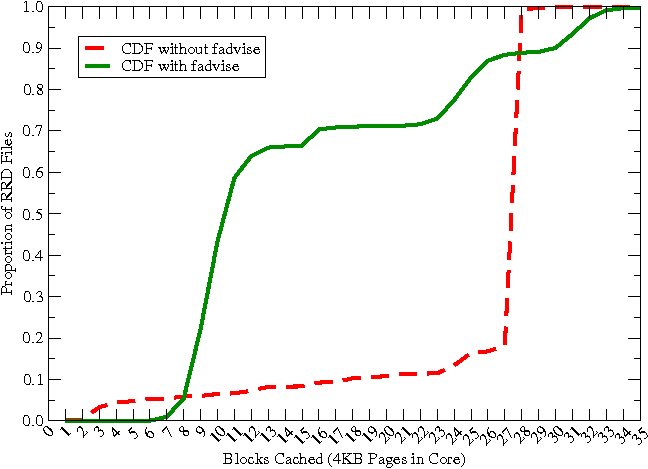
To better understand the buffer-cache behavior when updating a very large number of RRD files in near real-time, we developed both an analytical model and a simulation. Analytical modeling improves our understanding of RRDTool's file update behavior so we have a solid foundation on which to propose general solutions. The resulting model also provides a convenient way to calculate expected page fault rates without experimentation and measurement. The simulation allows us to gather a broader set of results than either the model or real-world experiments that would prohibitively require repeated reconfiguration of a real system's RRD files or physical memory.
We present an analytical model to predict the page fault rate given an RRD file configuration and an estimated number of pages available for the each RRD file in the system's buffer-cache memory. The modeling is done for a system with RRDTool patched to do fadvise RANDOM.
For this analytical model, we first need a list of the unique Primary Data Point (PDP) counts in increasing order, over which the consolidation is performed for every RRA (for AVERAGE, MAX, and so on). Recall that each RRA consolidates some number of PDPs that were gathered at the measurement interval, so an RRA's PDP count determines how often it is updated. For instance, for the RRD file shown in Figure 2, the ordered list of values of PDPs over all RRAs is: {1, 6, 24, 288}. These represent the periods of consolidation which in the case of Figure 2 refers to 5 minutes (1), 30 minutes (30/5 = 6), 2 hours (120/5 = 24) and 1 day (288). We also need a corresponding list of number of RRAs that are configured to consolidate each of those numbers of PDPs. That is for 2, since both MAX and AVERAGE RRAs are kept for each of the PDP value, the associated count list for {1, 6, 24, 288} is {2, 2, 2, 2}.
We denote the ordered PDP list as {x1, x2,..., xn} and the associated RRA count list as {c1, c2, ..., cn}. The cardinality of the ordered list is n. Hence in the example, {x1, x2, x3, x4} == {1, 6, 24, 288} and {c1, c2, c3, c4} == {2, 2, 2, 2}. Here, n = 4.
Now, for one update of an RRA, let B be the number of bytes written into the RRD file. In our case B = 16 bytes, for the two 8-byte floating-point values. For simplicity, we assume that each RRA is block aligned. This does not sacrifice generality since the average number of page faults due to crossing page boundaries is still predicted accurately as long as an RRA is at least one block in size, which is typically the case. The block size is S bytes. S = 4096 bytes in our case.
The number of updates that fit in a block is u = S/B. That is, after every S/B updates a page fault will occur. u = 256 in our case.
Let T be the time after which the primary data point is updated. T = 5 minutes in our case.
Now we estimate, for a single RRD file, the rate at which page faults occur given maximum p pages are available in the buffer-cache for use for this file (excluding the inode and indirect blocks.) When more than p pages are needed, LRU is used to evict pages to make place for newer ones.
The time estimated to a page fault, t, is the following: t = minimum(uT, xsT) where ∃s such that

The rationale behind xsT: For each RRA, a page is needed in memory. So we calculate the count of RRAs which can be fit in p-1 pages. (Only p-1 pages are available to the RRAs because one page is required for the first block of the RRD file that is always read as it contains the RRD metadata.) The subscript s is used to index into the ordered list to determine the interval after which the fault will occur. Each index into the ordered list is a discrete point in time when a fault will occur. For instance, if s = 2, then x2 implies fault would occur every half hour. The previous two equations give the index s based on the count of RRAs that can fit in p-1 pages.
The rationale behind uT: A page fault will surely occur after u updates.
The number of pages that will see a fault, m, after time t:


Rationale behind  : The number of pages that need
to be brought into memory is the count of the RRAs at a particular
index s, which cannot be held by p pages.
: The number of pages that need
to be brought into memory is the count of the RRAs at a particular
index s, which cannot be held by p pages.
Rationale behind  :
In our case, the update rate for x1 is six times the update
rate of x2. Therefore, the number of faults for
:
In our case, the update rate for x1 is six times the update
rate of x2. Therefore, the number of faults for
 .
We sum for all the fault rates through xn
relative to x1 and hence the
.
We sum for all the fault rates through xn
relative to x1 and hence the
 factor.
factor.
Rate of page fault, r, is given by m/t:


This model essentially predicts the average values shown with no readahead in Figure 13, as verified by simulation. Thus, the model provides a quick way to calculate either the expected page fault rate given a buffer-cache memory constraint, or vice-versa. In addition to this practical result, the analytical model led us to the following insights:
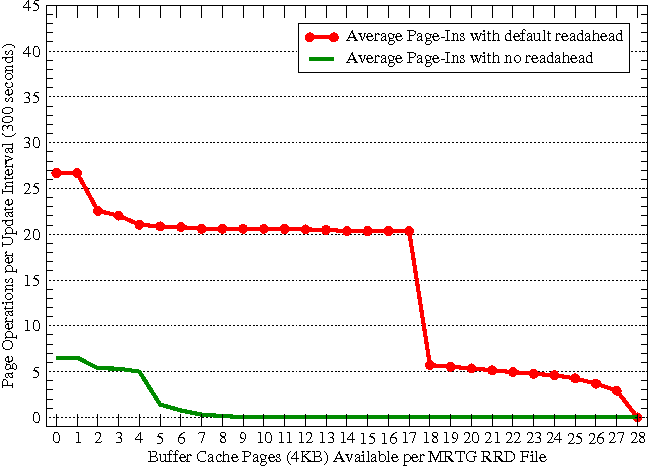
In addition to deriving the analytical model, we developed a page fault simulation. This simulation provides a means by which to validate the average page fault rate predicted by the analytical model. It also exposes the distribution, variance, and peak page fault rates by time of day.
First we simulated an entire lifetime of an RRD file's updates using RRDTool itself, but with synthetic input data. Before each update, we used our fadvise command's "don't need" technique to evict the file's cached (hot) pages. After each update we used our fincore command's technique to determine the hot pages and recorded the page numbers to a log.
Secondly, we wrote a buffer-cache simulator with a Least-Recently-Used (LRU) page replacement policy and replayed the page operation log recorded earlier to determine the page faults with varying numbers of buffer-cache pages being available per RRD file. While our SUT's buffer-cache is actually managed using the Linux 2.6 page replacement algorithm [8], similar to 2Q [10], we make the simplifying assumption that LRU is suitably similar for the purpose of simulation. In addition to the RRD file data blocks, we also simulated access to the file's inode and indirect blocks. On ext2 and ext3 file systems, a typical MRTG RRD file incurs an indirect lookup (and therefore an indirect block must occupy space in the buffer-cache) for each data block above the twelfth since only the first twelve blocks are directly referenced in the inode.
From the resulting simulated behavior, we can determine the expected page faults for a single RRD file over time. We then extrapolate by multiplying by the target number of RRD files to determine what amount of buffer-cache (as limited by physical memory) reduces page fault disk reads to an acceptable level.
We run the simulation for both the original RRDTool (default readahead). and the one patched with fadvise RANDOM (no readahead). Figure 13 shows the average number of page-in operations for both versions of RRDTool as a function of the number of buffer-cache pages available per MRTG RRD file. For the original RRDTool, when the number of pages available in the buffer-cache is less than 18, the number of page faults is very high. It falls at 18 because the 16 pages required for initial readahead are available in the buffer-cache at this point. (It is 16+2 because two extra blocks are required for the file inode and indirect blocks.)
Also, sometimes, the AVERAGE and MAX RRAs get written within these 16 pages. For the patched version with fadvise RANDOM, the average number of page-ins is close to zero if more than 7 pages are available in the buffer-cache. Page faults still occur when 8 pages are available in the buffer-cache but the average page-in rate is extremely low as shown in Figure 14. Note that more pages are written out at the aggregation intervals of 30 minutes, 2 hours and one day. The time of day 00:00 UTC shows the peak paging activity, when aggregation happens for daily RRAs.
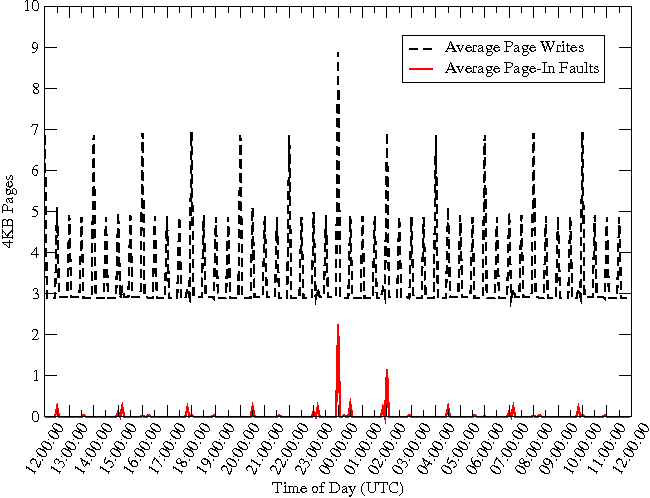
Our simulation results are validated by the earlier observations of the real system's performance with fadvise RANDOM. Specifically, the read and write pattern of the simulation in Figure 14 agrees with the observations of the real system with fadvise RANDOM in Figure 11, i.e., near zero read (page-in fault) rate. Earlier, using fincore in the real system, we also observed that most RRD files had only 8 pages in cache (Figure 12); this is the value that simulation shows (Figure 13) is the minimum required to achieve an average page fault rate of nearly zero.
We have shown that using either application-level buffering or application-offered advice dramatically improves the performance of RRD systems. In this section we show the performance and capacity scalability characteristics of a very large RRD and MRTG-based network measurement system by testing it first with just application advice, and secondly with advice plus application-level buffering. Thus, we explore the performance of the simpler of the two techniques and also the two techniques combined to determine the upper-bound to the scalability of such a system.
Our production MRTG system today monitors approximately 3,000 network devices with approximately 160,000 MRTG targets. Recall that each target is typically a pair of measurements such as byte, packet and error rates, inbound and outbound. Thus, the production system measures and records approximately 320,000 data points every five minutes. Having already found that either improvement technique results in satisfactory performance and thus does not push our system to its limit, we now construct an even larger system to study scalability.
We create an MRTG system three times the size by replicating our existing production measurement system so that there are three like-configured MRTG instances all running on one server. Our experimental procedure is to begin with approximately 160,000 (i.e., the production MRTG system) and then progressively add 20,000 targets every twenty minutes (10,000 from each of the replicated instances), until all three systems are running in parallel for a total exceeding 480,000 targets.
We first tested the scalability of MRTG with RRDTool patched to do fadvise RANDOM. The performance results are shown in Figures 15 and 16. This is the system we claim as the world's largest MRTG, operating with acceptable performance at around 320,000 RRD files. While there are some outlier points in the upper left of Figure 15, they occur at twenty minute intervals and there are exactly two per interval. Thus, these outliers are an artifact of the experimental procedure showing latency during just the very first loop iteration of each of the two new MRTG daemons as their the set of hot pages for their RRD files are read into buffer-cache. Beyond about 320,000 targets in the scalability test, performance is unacceptable because page faults increased and CPU utilization continually exceeded 65%, leaving little room for other tasks.
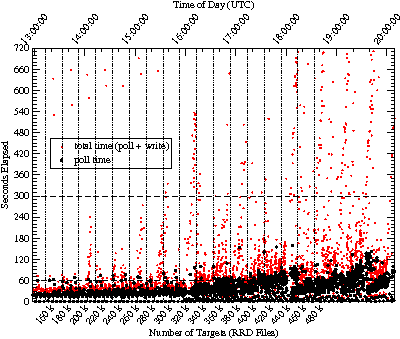

In Figure 16 note the spikes in CPU I/O wait state just following
1600 and 1800 hours. These are due to aggregations that occur every
two hours in typical MRTG RRD files. Furthermore, note that as the
number of targets increases, similar spikes are seen at half hour
intervals following 1800 hours. These spikes indicate that the number
of hot pages exceeds the capacity of the buffer-cache on the SUT,
resulting in an excessive page fault rate. We estimate our buffer-cache requirement to be 8 pages per file and 480,000 × 8 ×
4 KB = 14.6 GB. Although the SUT has 16 GB of memory in total, often
only 10 GB is available for buffer-cache. Ultimately, the high CPU
utilization interfered with SNMP polling (as evidenced by a drop in
network traffic) so the test was stopped.
Subsequently, we tested the scalability of MRTG using RRDCache combined with RRDTool patched to fadvise RANDOM. The performance results are shown in Figures 17 and 18. These combined techniques yielded the highest capacity, exceeding 400,000, but CPU utilization reached 100% and the RRDCachewriter could not complete its hourly updates within an hour, so an increasing backlog developed from which it didn't recover and the test was stopped.
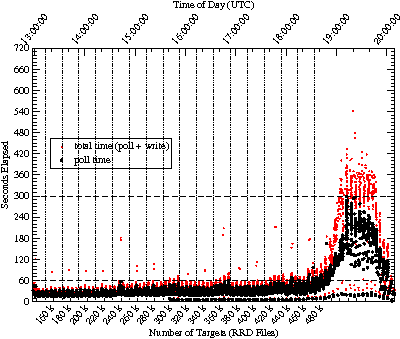

These scalability tests on our SUT show at least two capacity or performance limitations of large RRD and MRTG systems:
We've shown that MRTG and RRD systems can scale to hundreds of thousands of targets or RRD files. Without changing the RRD file read semantics, our fadvise RANDOM method allows us to scale to 320,000 target and files with acceptable performance on our system with 16 GB of memory. With slightly changed read semantics (because of the deferred RRD file updates), the RRDCache method scales higher. The factors that limit further scalability are (i) the CPU required for target processing (in perl) and (ii) RRDTool's aggregations at synchronized times across all RRD files. Further gains can be achieved by profiling and optimizing the system software (e.g., MRTG) and by appropriately sizing the systems physical memory so that an even larger buffer-cache is available.
Our work is informed by prior operating system and application performance improvement techniques.
Within the operating system, better buffer-cache management techniques can help reduce the number of disk reads and writes. There are a number of policies described in the literature (e.g., FIFO, LRU, LFU, Clock, Random, Segmented FIFO, 2Q [10], and LRU-K). The readahead by the OS can limit the amount of useful data that can be cached. In some circumstances, improvements to the adaptive readahead algorithm can significantly improve performance [14].
The ability to accept hints or advice from applications with the aim of more efficiently managing resources and improving performance was implemented in the Pilot operating system [20]. An interface by which operating systems can accept such advice specifically to provide buffer management has long-since been suggested [25]. Later work finds that application "hints" to inform the operating system of file access patterns improves performance [15]. Today, some operating systems have support for application advice via the fadvise and madvise APIs [19].
A related approach is to the change the kernel to include functionality which enables application guided buffer-cache control [2]. Another possibility is to simulate the cache replacement algorithm to build a reasonably accurate model of the contents of the cache for reordering reads and writes [4].
Within our version of the operating system (Linux 2.6), there are four I/O scheduling algorithms available: Completely Fair Queuing (CFQ) scheduling, deadline elevator, NOOP scheduler and Anticipatory elevator scheduling [21]. The scheduling algorithm can prioritize individual I/O requests, such as reads over writes, and therefore affects application performance when page faults occur.
A number of software systems inspired by the original MRTG have improved its performance in some ways. The current MRTG, Cricket [1], Cacti [5], and Torrus [23] applications use RRDTool [13] to achieve improved performance. Cricket [1] allows configuration of more parallel measurements per file, but this offers only a modest performance improvement since tens to hundreds of thousands of RRD files would still be required. RTG [3] made significant changes in the polling (but that is not our bottleneck) and replaced the file I/O with relational database I/O. We have no reason to believe this would offer better I/O performance, and it significantly changes the user interface to the data. JRobin [11] completely reimplements RRDTool in java, improving performance in some areas but decreasing it in others and modifying the RRD file format in the process.
Recently, RRD users have proposed design changes or made customizations to introduce an application-level cache maintained by a daemon that intercepts updates [22, 12, 9].
Our investigation and experimentation thus far suggests at least the following potential items of future work.
In conclusion, we've provided a general analysis method and two new tools, fincore (available at [18]) and fadvise (available at [16]), that expose readahead and buffer-cache behaviors in running systems. Without such tools, these performance-critical aspects of the operating system are hidden from system administrators and users.
By both modeling and simulation, we've provided a detailed analysis of the I/O characteristics of RRD file updates. We've shown how the locality of RRD file accesses can be leveraged, limiting page faults and disk I/O, resulting in improved performance and scalability for RRD systems. We've found that RRD buffer-cache utilization and page faults are defined by subtleties in the RRD file format and RRDTool's access pattern, rather than simply being defined by file size. This is advantageous because it means that larger RRD systems can be operated than would otherwise be thought.
We've outlined two effective methods to improve RRD performance. The first, RRDCache (available at [6]), is what we've called application-level caching or buffering. The second, for which we provide a patch to RRDTool (available at [17]), issues application advice to the operating system to select readahead and buffer-cache behavior appropriate for random RRD file I/O. While the two methods are starkly different, both eliminate the buffer-cache memory bottleneck that has been observed in large RRD network measurement systems. Conservatively, either technique triples the capacity of such systems. Together, these complementary techniques can be applied to maximize performance.
Finally, we've shown that system tuning and minor capacity-enhancing code changes improve Round Robin Database performance so that RRDTool can be used for even the largest managed networks.
We thank Hideko Mills for her support, Michael Swift for his valuable input, and Robert Plankers and Kevin Kettner II for their assistance with system administration. Mark Plaksin provided helpful review feedback.
kSar [7] proved useful for conveniently visualizing sar data.
This work is a collaboration with the University of Wisconsin's Division of Information Technology.
David Plonka is a graduate student and research assistant in
Computer Sciences at the University of Wisconsin-Madison. He received
a B.S. from Carroll College in Waukesha, Wisconsin in 1991. He can be
reached at  .
.
Archit Gupta is a graduate student in Computer Sciences at the
University of Wisconsin-Madison. His primary interest areas are
Systems and Networking. He can be reached at  .
.
Dale Carder is a senior network engineer for the University of
Wisconsin-Madison and WiscNet. He can be reached at
 .
.